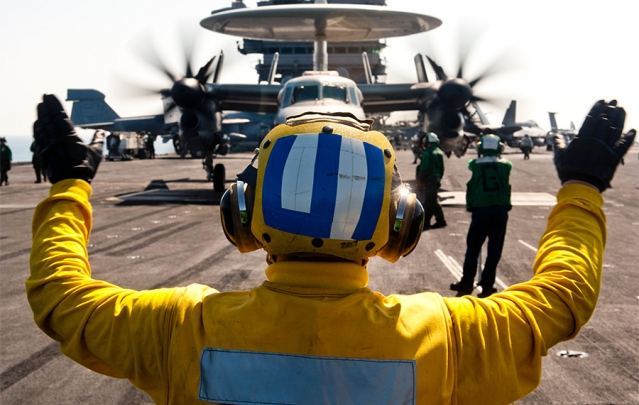Washington’s Self-Deterrence Problem in Syria
James F. Jeffrey/Washington Institute/February 12/16
If Moscow can get away with boldly flouting U.S. interests in a key American security zone such as the Middle East, where might it interfere next, and at what cost to the international security system?
As Secretary of State John Kerry visits Germany for the 52nd Munich Security Conference this week, questions about Washington’s hesitant policy in Syria continue to mount. During testimony before the Senate Armed Services Committee on December 9, Secretary of Defense Ash Carter and Joint Chiefs vice chairman Gen. Paul Selva confirmed the notion that the Obama administration has effectively “self-deterred” itself out of more robust action in the war, including the oft-recommended move of establishing a safe haven in northern Syria. As Selva put it, “We have the military capacity to impose a no-fly zone. The question that we need to ask is, do we have the political and policy backdrop with which to do so?”
The answer thus far has been no. Between Moscow’s massive, indiscriminate bombing campaign since September and the resultant successes of the Syrian-Iranian-Russian alliance in the past two weeks, the Obama administration has taken no effective military or political action to counter the Kremlin’s moves. While direct confrontation would not have been wise, traditional U.S. responses to such provocations have typically included ostentatious military deployments, concrete steps to stymie a Russian military victory, and efforts to reassure allies through “presence.” Yet almost nothing of the sort has occurred during Moscow’s Syria intervention. Rather, the administration appears to have deterred itself from action, with dramatic effects on the war and potentially serious implications for the entire U.S. global security system.
The latest developments — namely, the suspension of the Geneva peace talks, and a sweeping offensive by the Russian “axis” to take Aleppo and defeat the opposition in the populous western provinces — deal a bitter blow to the administration’s stated strategy of seeking a Syria free of Assad and a Middle East free of raging Sunni-Shiite conflict. Yet something much larger is at risk as well: the integrity of U.S. security relationships in the region since the 1970s. The rapidity with which Russia, the Assad regime, and their Iranian-led Shiite militia allies have achieved success on the ground, juxtaposed with Washington’s inability to play its traditional military balancing role, could undercut faith in the United States, especially given the administration’s slow, almost timid military campaign against the Islamic State. As one U.S. official told the Daily Beast on February 7, Moscow and Washington’s differing approach “tells the region who the players are. America is feckless and Russia and Iran are reliable allies.”
Analysts will long sort out how the United States arrived at this impasse. The region’s critically dysfunctional condition bears a share of blame, as does President Obama’s general skepticism toward the use of force. Yet much of the blame lies with the administration’s self-deterring reaction to Russian power projection in a traditional U.S. security arena. Almost immediately after Russian forces entered Syria last fall, the president underlined that the United States would not directly confront Moscow there. Instead, he spoke dismissively of the intervention, calling it a quagmire for Russian forces and thus absolving himself of the need to do anything. But he did not say how he would respond to Russian aircraft targeting U.S.-supported rebel factions. Instead, he rejected the notion of broader action — presumably to include a no-fly or buffer zone — as “mumbo jumbo” by people who do not know what they are talking about.
The administration did eventually deploy F-15 air-to-air combat fighters to Incirlik Air Base in southern Turkey. Almost simultaneously, however, it withdrew U.S. Patriot surface-to-air missile units that had been placed in Turkey under NATO command since 2012 in response to the Syria crisis (though other NATO Patriot units remained). And soon thereafter, the F-15s were withdrawn as well.
The U.S. reaction to Turkey’s November shootdown of a Russian aircraft further highlighted the administration’s overwhelming concern for avoiding incidents. While the State Department declared on November 24 that “we do stand by Turkey as a NATO ally,” the president emphasized the need to deescalate. To be sure, some caution was understandable given the danger of that situation, and the political wisdom of Ankara’s move was questionable. Yet the genesis of the incident was a Russian incursion into a Turkish province long claimed by Moscow’s ally, the Syrian regime. In light of Ankara’s legal justification, Russia’s responsibility for entering a sensitive area, and Turkey’s NATO status, the U.S. response was lukewarm at best.
Seen in this context, General Selva’s December testimony was no surprise. Speculating about the military feasibility of establishing a buffer zone in the north, he asked, “Could we do it? The answer is yes. Are we willing to engage the potential of a…direct conflict with the Syrian integrated air defense system or, by corollary, a miscalculation with the Russians should they choose to contest the no-fly zone? The consequences of activity by surface-to-air missile systems and air-defense aircraft have to be factored into the equation. We have the capability to deal with those. The consequence is a direct confrontation with Russia or Syria.” And in January before the same Senate committee, former National Security Council staffer Philip Gordon, who often channels the administration’s thinking, complemented Selva’s military self-deterrence with a dose of political self-deterrence. After declaring that “almost any peace in Syria would be better than the current war,” he not only ruled out direct American intervention, but also argued against increased support for the rebels. “Given the strong Russian and Iranian commitments to support the regime,” he argued, “such an escalation would [lead] to a new counter escalation.”
True deterrence is a much more readily understandable obstacle to action than “self-deterrence.” When an opponent has a preponderance of force and a priority political interest in a given situation — that is, capabilities and intent, the two key military and geostrategic determinants of action — then deterrence is real, emanating from the other side, and not something one side imposes on itself. Examples include Russia’s actions in Crimea and, to some degree, Beijing’s in the South China Sea. There are real limits to what Washington can do to challenge such actions, however illegal, because the governments in question see those areas as essential to their interests — they have the clear intent to defend them and the military capability to do so even against the United States, short of all-out war.
This is demonstrably not the case in Syria, though. Russia is not without legitimate interests there, most notably a longstanding relationship with the Assad regime and a naval base on the Syrian coast. Yet such interests are minor compared to America’s. While Syria itself is not critical to the United States, it is nestled in the center of a critically important U.S. security zone, with one of Washington’s strongest NATO allies, Turkey, just to the north and one of its closest friends, Israel, to the south. Two other close security partners, Jordan and Iraq, also border Syria. Moreover, Saudi Arabia and other key Gulf partners, along with Ankara and to some degree Jordan, all support the Syrian opposition, and most see the war as the region’s main security challenge. Washington itself has called for Assad to leave since 2011, supported its partners in aiding rebel groups, and conducted CIA train-and-equip operations out of Jordan. More broadly, the United States has played the preponderant role in Middle East security since the 1970s, and countered Russian moves there in 1973 and 1980. Thus, America would presumably have the intent to protect this important position.
It clearly has the military capability to do so as well, as General Selva indicated. Russia initially intervened with only thirty-four fighter aircraft and a few helicopters. The Syrian air force is no longer combat effective, and Iran cannot project airpower very far. Yet the United States typically has between 150 and 200 combat aircraft in the Middle East, while four of its nearby partners (Turkey, Saudi Arabia, Israel, and Egypt) have at least 200-300 each, and Jordan almost 100 more. Syrian and Russian air defense systems are a threat, of course, but as General Selva noted, U.S. forces can cope with them. Furthermore, Russia’s aircraft face NATO Patriot batteries in southern Turkey, additional Patriot batteries in Israel, advanced U.S. radar systems just to the south of Syria, and highly capable Aegis antiaircraft systems on ships off the coast.
In other words, Vladimir Putin was the one who inserted himself into an extremely dangerous situation where the correlation of forces was tipped dramatically against him, and where the United States would presumably have every intention of countering him. Yet he seems to have won his bet, not because the United States was incapable of acting, but rather because Washington decided it was too risky to do so.
Granted, toying with a nuclear power always carries risks, but surely Putin knew this as well when intervening in an American security zone. The United States did not let such risks deter it from reacting to Russian moves into Cuba in 1962, into the Middle East in later decades, or into Central America in the 1980s. Today, however, Washington tends to self-deter even in confrontations with nonnuclear powers, as seen in President Obama’s frequent admonitions that escalating the campaign against the Islamic State could lead to “thousands of casualties,” another Iraq war, and a decade of forces committed.
Three conclusions flow from these observations. First, having “blinked” despite overwhelming military superiority, the United States will have a hard time responding now that Russia seems to be moving from victory to victory in Syria, and the difficulty will only grow the longer Washington waits. Second, if Putin can get away with such activities in Syria, where might he act next, whether he has military superiority or not? If U.S. deterrence fails in one place out of a simple lack of will and intent, might it not fail elsewhere? Third, what happens if Putin miscalculates and blunders into some region where even President Obama feels compelled to act? Such questions show how continued inaction is increasing the danger to U.S. interests and the international security system — not, as the administration believes, forestalling it.
James Jeffrey is the Philip Solondz Distinguished Fellow at The Washington Institute and former U.S. ambassador to Iraq and Turkey.





















